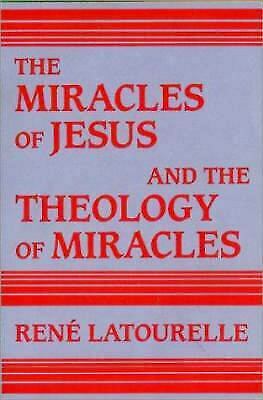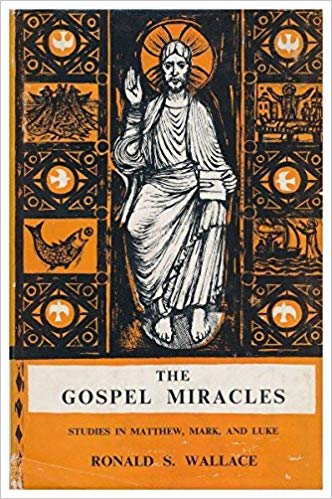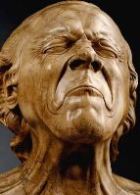Jesus & the Madman
What’s on this page?
- Key ideas about Jesus & the Gerasene madman, from popular books on the gospels
The destruction of property, the pigs, not the healing of the two men, seems to be the crowd’s priority, and those in the region ask Jesus to leave. Jesus’ power over demons is observed but not appreciated. Other, material issues matter more.
 Luke alone notes that the man was naked, adding a theme of shame.
Luke alone notes that the man was naked, adding a theme of shame.
Mark details the strength of the possessed man, who could not be bound in any kind of restraint. He continually injured himself on the stones. The scene paints a tragic picture of self-destruction.
Both accounts note that Jesus also extracted the name of the demons, ‘Legion,’ indicating that he was significantly outnumbered. On the surface it is an uneven fight, but Jesus’ authority is confirmed when they enter the swine, which Mark numbers at about two thousand. This helps us appreciate the extent of economic impact of what the demons did to the swine.
Unlike Matthew, Mark and Luke point out how part of what created the fear was seeing the man in a sane condition!
Jesus according to Scripture, Darrell L. Bock, Baker Book House Co., Michigan, 2002, p.165
This is doubtless the most disconcerting and scandalizing of all the miracle stories. For centuries it has provided the enemies of the Church with a butt for sarcasm and ridicule. Just think: a story about a demon deceiving and then deceived, and ending up in the sea with the two thousand swine which he has chosen as a place of residence! Even Catholics are embarrassed at having to present the story as authentic and serious.
 The difficulty is all the greater inasmuch as often it is only the peripheral aspects of the story that capture attention:
The difficulty is all the greater inasmuch as often it is only the peripheral aspects of the story that capture attention:
- Were there one or two possessed individuals?
- How to excuse the destruction of the two thousand swine?
- What place along the Lake of Gennesaret is steep enough for the animals to hurl themselves over it? The traces of such a mass self-destruction should still be discernible even today.
The most harebrained explanations abound and make the rounds: from those defending the strictest historicity to those indulging in the most grotesque fantasies.
Let me say straight off that readers looking for certainty on every detail will be disappointed. Our primary concern must be to know whether or not Jesus restored physical and psychic balance to an unfortunate lunatic. On other points we shall reach at best various degrees of probability. Historians do not ask for more than that, nor do sincere believers.
The Miracles of Jesus, Rene Latourelle, p.111
‘The people of the town undoubtedly felt that the man was mad, for his appearance and behavior conformed to the popular diagnosis of insanity. In accordance with the practice of the day they had attempted to bind him by chains to protect themselves from his violence.

The Gospel of Mark, Lane
When this proved to be futile, they had driven him off to wander restlessly in the wild hill country and to dwell in the subterranean caves which served as tombs and dwellings for the poorest people of the district.
At intervals during the night and the day he would be seen among the tombs or on the mountains, wildly shrieking, cutting his flesh with sharp stones, attempting to destroy himself and bring to an end the torment of an unbearable existence.’
__________________________
‘According to the Talmud there were four characteristics of madness: walking abroad at night; spending the night on a grave; tearing one’s clothes; and destroying what one was given. This man demonstrated all four characteristics.’
__________________________
‘Jesus now demands to know the demon’s name, and for the first time there is indicated the full degree of distortion to which the man was subjected: not one but a multitude of alien forces had taken possession of the volitional and active ego of the man (“My name is Legion, for we are many”). It is difficult to know what is meant by the term. The answer may express the man’s sense of being possessed by an aggregate of uncoordinated impulses and evil forces which have so impaired his ego that the spirits speak and act through him. If so, this response may be an appeal for compassion. It is a pathetic admission of the loss of all sense of identity.’
The Gospel According to Mark, William L. Lane, William B. Eerdmans Publishing Co., Michigan, 1974, p.182-5.
The account (in Mark 5:1-20) is so vivid, immediate and unimaginable as to be true, presenting again a strong case that the story rests on the recollection of someone who was there (Peter, once more?)
A moment’s reflection prompts us to feel the suffering of all those involved in this tragic scene. The local townspeople were anxious for their welfare, as witnessed by their many unsuccessful attempts to capture this frightening man. We can readily imagine the sense of helplessness of the man’s immediate family too, forced to live with the tragedy of their deranged relative.

The unclean spirit gives his name as Legion, revealing something of the greatness of the man’s own inner pain and sense of dislocation. As the man advanced, he fell on his knees before Jesus, not in the menacing mock worship of an earlier occasion (see 3:11) but in a sincere, if confused, manner.
________________________________
Mark concludes his story with starkly contrasting human responses. The owners of the pigs, and others from the neighboring region who had been told what had happened, converged on Jesus and the man who had been demon-possessed. They were afraid, sensing the presence of the supernatural, when they saw the previously deranged man sitting there, dressed and in his right mind.
Yet despite the astonishing change in the man they began to plead with Jesus to leave their region.
We might have expected a request for Jesus to come and bring his powers to bear on others similarly afflicted in the area. But they asked him to go away, a sad commentary on their distorted sense of priorities which preferred property to people.
Mark lets us not only see the dramatically changed man but also hear him beg to go with Jesus as one of his group Did he not owe him his life?
Mark, the Servant King, Paul Barnett, Aquila Press, 1991, p.83
‘In these days in Gadara a disordered spirit of lawlessness found its expression in the brutal and stupid behaviour of these demoniacs.
 Today the same deep-rooted perversion of the human mind and heart and nature expresses itself in more apparently civilised and better dressed forms. It expresses itself sometimes in mass hysteria, sometimes in mob violence, sometimes in waves of juvenile delinquency or anti-semitism.
Today the same deep-rooted perversion of the human mind and heart and nature expresses itself in more apparently civilised and better dressed forms. It expresses itself sometimes in mass hysteria, sometimes in mob violence, sometimes in waves of juvenile delinquency or anti-semitism.
Sometimes it ultimately finds its expression in the determination of a nation, fascinated and led by disordered minds, to wage war and work havoc on the earth in pursuit of wild and senseless ambition.
The Gadarene demoniac who was such a problem “lived among the tombs; and no one could bind him anymore, even with a chain; for he had often been bound with fetters and chains, but the chains he wrenched apart, and the fetter: he broke in pieces; and no one had the strength to subdue him.”
The civil authorities of Gadara had done their best to maintain public order and decency by force. They reinforced the police, forged the strongest possible chains, issued the strictest instructions, but the situation was beyond their control. Each time new and stronger chains were tried they worked only for a very short time and the disorder broke out afresh.
The Gospel Miracles: Studies in Matthew, Mark and Luke, Oliver & Boyd, Edinburgh, 1960 p.65.





